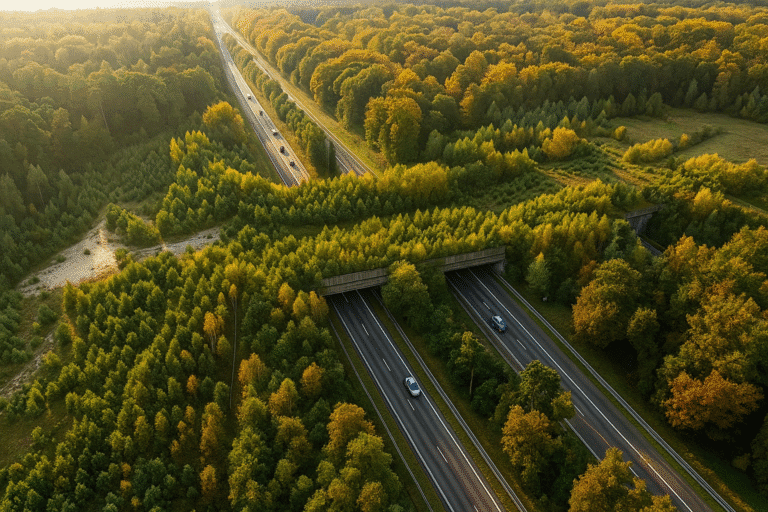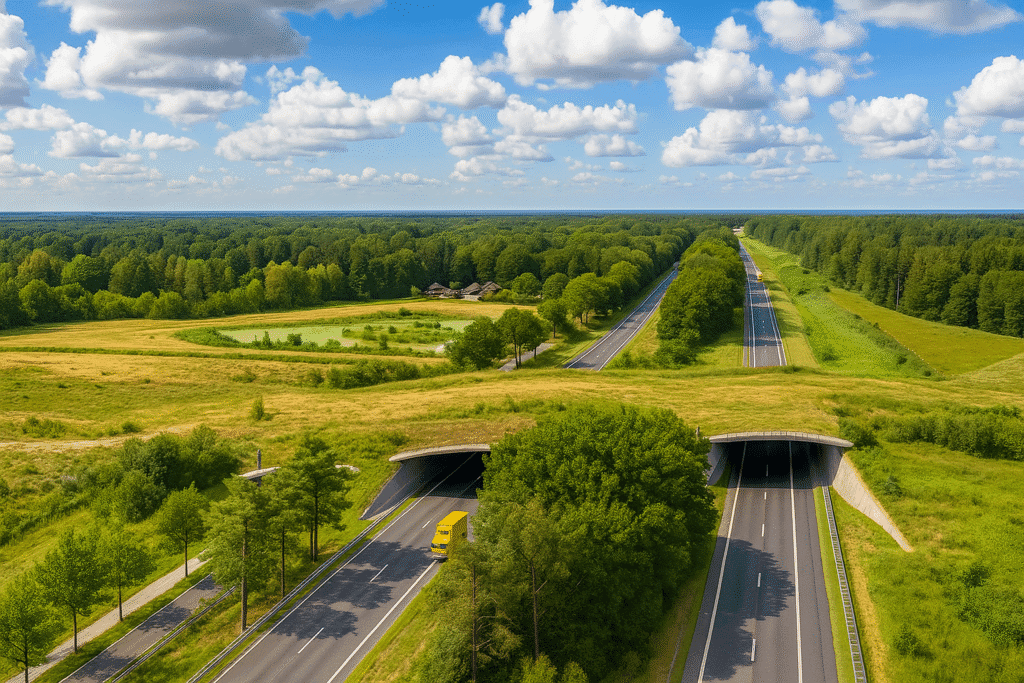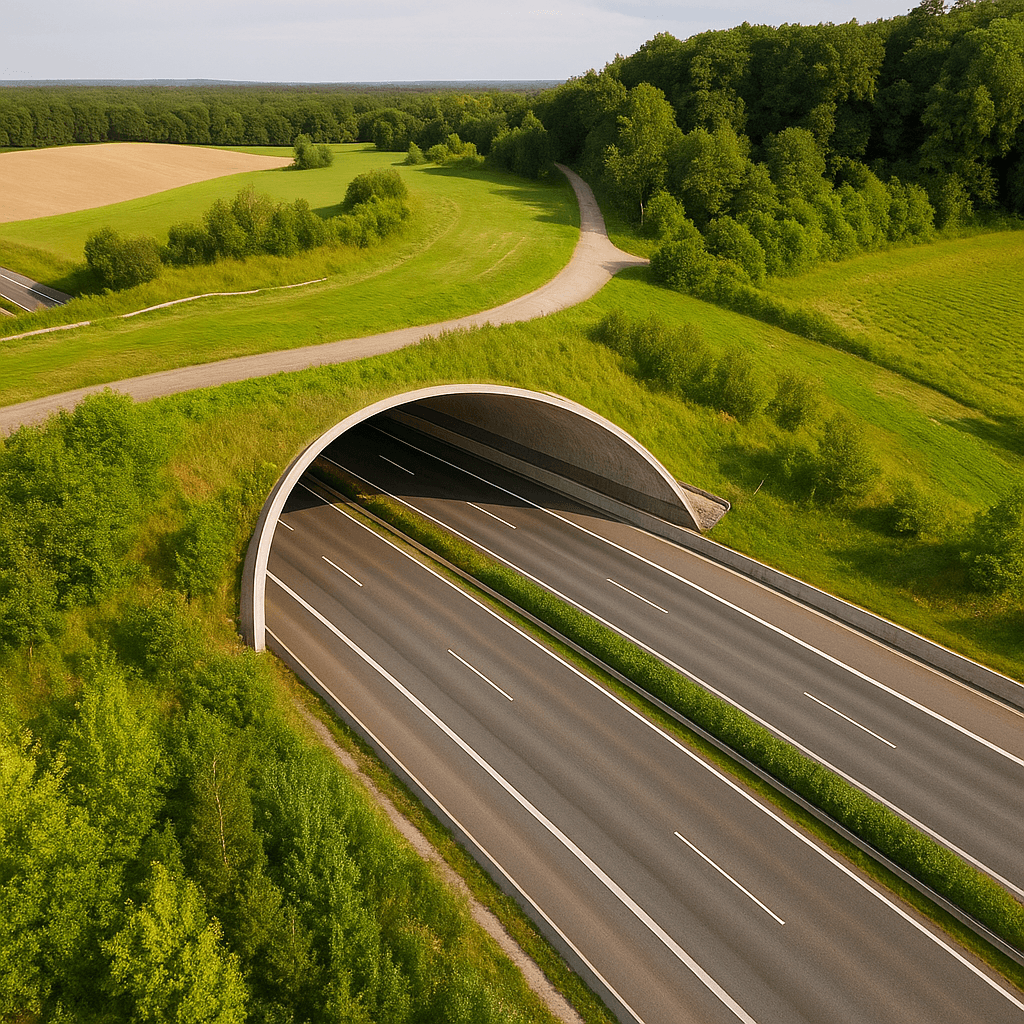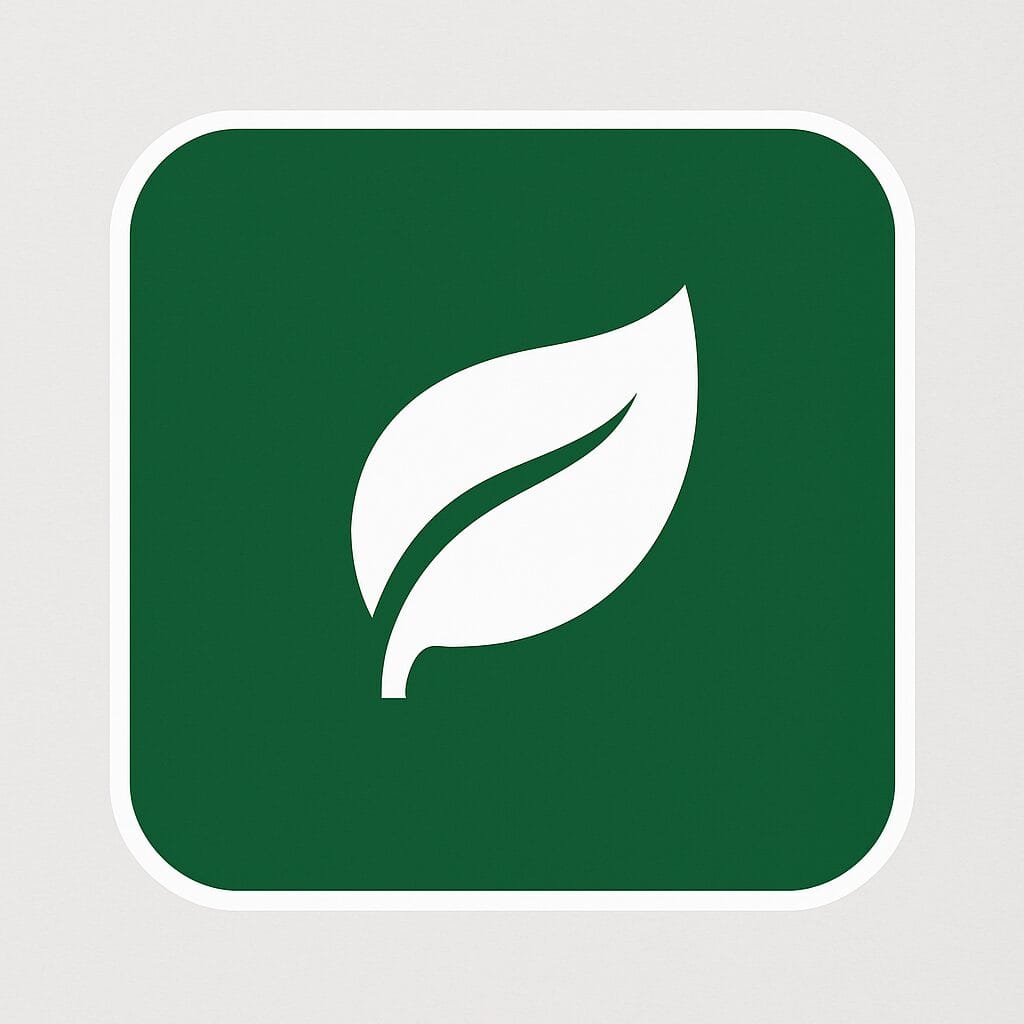
Table of Contents
ToggleWhy wildlife needs a way ?
In the modern days we can observe that cities are growing roads, dams and buildings continuously. Sometimes these infrastructures collapse with natural habitat leaving few green area left. This means danger for animals. Migration routes, crossings, and fragmented ecosystems are now vanishing.
But here is an innovative solution: green bridges for animals, which are also known as urban wildlife bridges or wildlife crossings. This structure helps to reconnect the ecosystem divided by urban Sprawl. They enable safe passages for animals and prevent collisions on busy roads. In this blog we will explore about green bridges for animals, green bridges for wildlife benefits and urban wildlife overpass examples.
What are green bridges
Green bridges for animals, also known as wildlife crossings or urban wildlife bridges, are specially designed overpasses for animals to cross human-made barriers like roads and highways. But don’t assume it is only a concrete structure with patches of grass. Urban wildlife bridges are carefully made for ecological pathways.
Let’s cover its design too, unlike pedestrian bridges or standard overpasses green bridges are :
- Planted with native vegetation to mimic the natural habitat
- Equipped with guiding barriers that attract animals safely towards them
- Build with noise-reducing materials to reduce noise stress on animals
These bridges are designed based on animals’ behaviour, size, and environmental conditions. Some bridges are wide for deer and bears, and others are narrow and quiet. Overall the core idea is to connect fragmented ecosystem naturally.

Green bridges for wildlife benefits
According to the Federal Highway Administration (FHWA),theree are more than 1 to 2 million wildlife–vehicle collisions with large animals each year on U.S. roads. More than 1,000,000 wildlife vehicle collisions… cost over $8 billion annually, source : Federal Highway Administration – Wildlife Crossings Program
Green bridges for animals not only provide a safer pathway but they also have many benefits let’s discuss them :
1. Reduce Animal vehicle collisions
One of the most immediateimpactst of urban green bridges is thattheyt reduce wildlife collisions withvehiclese and reduce accidents. Highways are made through natural habitats which force animals to cross the dangerous roads and wildlife crossings guide animals under or over the traffic corridors safely.
2. Reconnect fragmented habitat
Cities often divide forest and natural wildlife into small isolated fragments. Green bridges connect all these units and allow animals to migrate, hunt and breed across larger territories.
3. Preserve genetic diversity
When animals are trapped in small area,s they are unable tobreedg effectively. This leads to genetic diversity weakness and disease. Wildlife bridges restore general flow between whole ecosystem which helps to maintain and adapt to new climate changes over time in animals.
4. Support urban biodiversity
As I said earlie,r Wildlife crossings are not just for large animal;, many crossings are supported with native plants, trees, shrub,s and grasse,s whichcreates a whole habitat thatsupportst birds, reptiles, pollinator,s and small mammals. They become biodiversity corridors that enrich the ecological fabric of urban areas.
5. Fosterhuman-wildlifee coexistence
As you know green bridges reduce dangerous encounters and preserve wildlife movement, this key feature helps to reduce tension to expand cities and surrounding nature. Now cities can expand with fewer collisions, less habitat conflicts and healthier ecosystem. All thesecontributeston a balanced urbanenvironments.

Urban wildlife overpass examples
1. Banff national park, canada
In Canada, Banff has 40 wildlife crossings structures including overpasses and underpasses across the trans canada highways. These green bridges for animals often serve grizzly bears, elk, wolves, and many other species with more than 150,000 documented crossings to date. Animal collisions have dropped by 80%, according to Parks Canada. This area is now a global case study.
2. Wallis annenberg wildlife crossing, california (USA)
It is an under-construction green bridges in Los Angeles, which span ten lanes of pathways, reconnecting habitats for mountain lions and other wildlife in the Santa Monica Mountains. It is designed with sound barriers, vegetation and natural topography. It is expected to be the largest urban wildlife crossing in the world when it is completed.
3. Ecoducts in the Netherlands
The Netherlands leads Europe in wildlife-friendly infrastructure with over 600 Ecoducts, green bridges, and underpasses which are integrated into highways. The Netherlands has a dense road network, these structures help deer, boar, honey badgers, and reptiles to move safely.
4. Mandai wildlife bridge, Singapore
It was opened in 2019 with a 140m long bridge that connects two parts of Mandai rainforest, which had been split by a busy road. It was designed to support monkeys, pangolins, squirrels and birds. It is also the part of Singapore’s urban biodiversity strategy. Native plants and natural soil were used to encourage use by local species.
5. Compton road overpass, brisbane Australia
This overpass combines fencing, underpasses, and canopy bridges that create a multi-species crossing system. Studies have recorded wallabies, possums, snakes and even gliders using this structure. It is a model for how urban roads in suburban areas can be retrofitted for wildlife safety.
Challenges against urban wildlife bridges
1. High construction cost
Wildlife overpasses are very costly. Each crossing can cause around $1 Million to $90 Million depending on the location, size and design. For low-budget cities, it is hard to prioritize wildlife crossings over roads, schools, and hospitals, even if animals get long-term benefits.
2. Limited space in dense urban areas
Finding the physical space for wide, vegetated overpass is difficult in tightly packed cities. Overpasses must be long and wide so that they can give a natural vibe to animals, but many roads in urban areas have little room to build them.
3. Ensuring animal usage
Just because a bridge is built does not mean animals will definitely use it. Hence, authorities should counter these issues – poor placement, unnatural design which causes animals to avoid them. Cities must invest in ecological studies, tracking data and behavioral research to build crossings.
4. Maintenance and long-term monitoring
Green bridges require regular monitoring- Vegetation must be trimmed and replanted, fences need repair, camera traps and sensors need maintenance. Many cities ignore this ongoing cost of maintenance which leads to degraded functionality over time.
5. Lack of public awareness
Wildlife connectivity isn’t a big issue for most voters and policymakers. It is often ignored and many see it as a luxury rather than a necessity for wildlife. Without public pressure or media support, these infrastructures often get delayed or dropped from the list.
Green bridges are not impossible to build, but they require funding, vision, and long-term commitment. Fortunately, most cities are now recognising it as necessary, not as optional.

Future of wildlife crossings in urban design
Due to biodiversity loss and climate adaptation, green bridges are moving from niche solution to mainstream urban planning tool. The next generation of wildlife crossings will be more effective and advanced.
Wildlife crossings are now being combined with larger green infrastructures like urban forest green corridors and nature-based flood control. AI-powered cameras, thermal sensors, and motion detectors are being used to track animals’ behaviour in real time. This allows city planners to study patterns, species trends, and to optimise bridges after construction.
Cities are now adopting existing roads, overpasses, and even rail lines into wildlife-friendly structures. Old concrete can become new lifeline for urban species with the right vegetation, fencing and design tweaks. I found that countries like Netherlands Canada and Australia are already establishing wildlife corridors into transportation policy. More governments are adopting “no net loss” in biodiversity frameworks.
Green bridges are no longer symbolic or luxury; they are becoming essential tools for urban resilience, ecosystem recovery, and safer human-wildlife coexistence.
Why green bridges Matter more - Final thought
Green Bridges for animals are not just a clever idea, they are a practical and science-based way to restore ecological balance. They connect broken habitats, reduce road kills and protect genetic biodiversity. A growing number of urban wildlife bridges proves that humans can design with empathy. In our era where biodiversity loss is accelerating these bridges not only help animals to cross bridges they have a lots of benefits too. Stay tuned with Ventrofy.
You may like-
FAQs
What is the purpose of green bridges for animals ?
Urban wildlife bridges help animals to cross roads highways and other barriers. It’s main purpose is to reduce road accidents, reconnect habitats and support biodiversity in those areas which is affected by human development.
Do green bridges actually works ?
Yes, urban wildlife bridges can actually reduce vehicle collisions with animals by providing them a safe pathway. They also help in gene flow and allow species to repopulate them in fragmented habitats.
How much does it cost to built a wildlife overpass ?
The cost varies because it depends on the size, location, and design. But through a rough idea we can conclude that –
- Small underpasses : $300,000 to $1 Million
- Large vegetated overpasses : $5 Million to $90+ million
